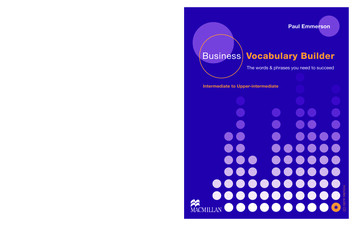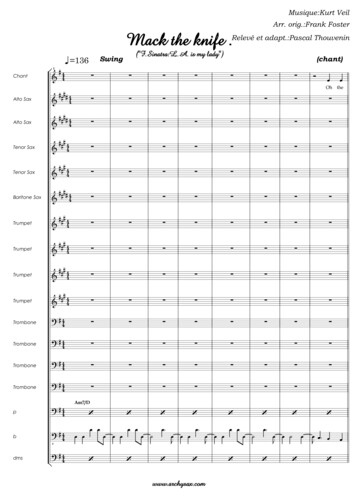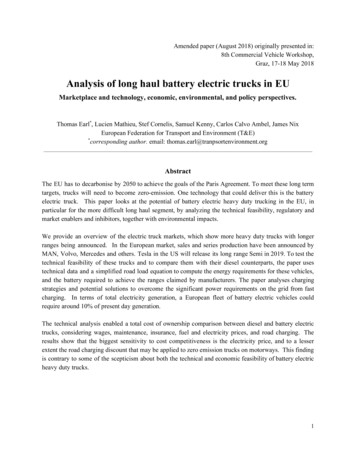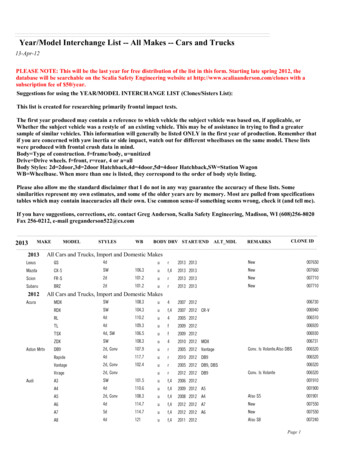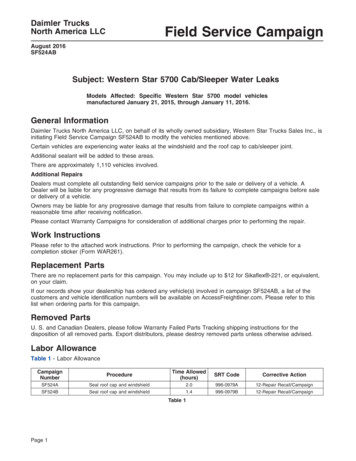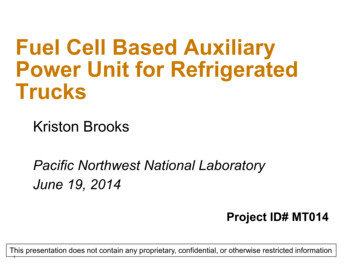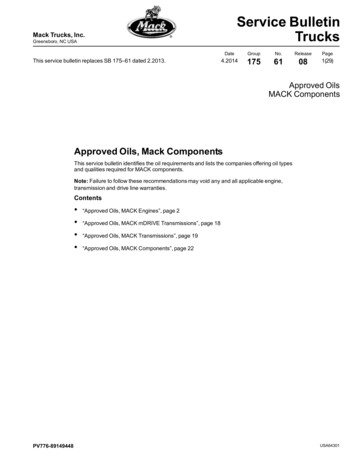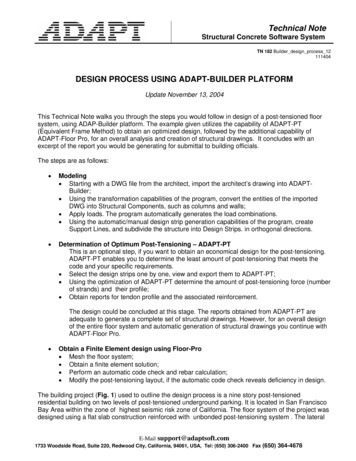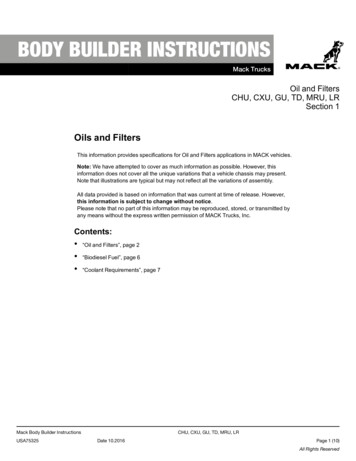
Transcription
BODY BUILDER INSTRUCTIONSMack TrucksOil and FiltersCHU, CXU, GU, TD, MRU, LRSection 1Oils and FiltersThis information provides specifications for Oil and Filters applications in MACK vehicles.Note: We have attempted to cover as much information as possible. However, thisinformation does not cover all the unique variations that a vehicle chassis may present.Note that illustrations are typical but may not reflect all the variations of assembly.All data provided is based on information that was current at time of release. However,this information is subject to change without notice.Please note that no part of this information may be reproduced, stored, or transmitted byany means without the express written permission of MACK Trucks, Inc.Contents: “Oil and Filters”, page 2“Biodiesel Fuel”, page 6“Coolant Requirements”, page 7Mack Body Builder InstructionsUSA75325CHU, CXU, GU, TD, MRU, LRDate 10.2016Page 1 (10)All Rights Reserved
Oil and FiltersMP7, MP8 and MP10 EnginesEngineOil CapacityMP 7 and MP 844 quarts (42 L)MP 1055 quarts (52 L)Approved OilsFor a complete list of Approved Oils used in Mack Engines, transmissions, and other components, refer to Approved Oils,Mack Components.MP7, MP8, and MP10 (US 2010) Engine Oil Type / QualityEngines meeting the 2010 and later emissions requirements are designed with exhaust aftertreatment systems requiring anoil that meets MACK EO-O Premium Plus quality standards for model year 2010 and later MACK engines. The MACK EO-OPremium Plus quality standard is based on the API CJ-4 engine oil specification, but has additional performance requirements essential to adequately protect the MACK engines at the drain intervals specified. Pre-2010 engines also work betterwith the recommended engine oils. They are not required, but are strongly recommended.Recommended SAE Grades For EnginesMack Bulldog EO-O and Mack Bulldog Premium Plus EO-O10W-30, 15W-40CAUTIONExtra oil additives must never be added to any engine oil used.W20556911 Typical Spin-On Oil Filter (MP8 Engine Shown)Mack Body Builder InstructionsUSA75325CHU, CXU, GU, TD, MRU, LRDate 10.2016Oil and FiltersPage 2 (10)All Rights Reserved
Rear Axle Oil ViscosityThe following chart indicates the recommended rear axle oil weights.Recommended SAE Grades for Rear AxlesGO-J – Mineral BaseGO-J Plus – Synthetic BaseTO-A Plus – SyntheticSAE 80W-90, 80W-140, 85W-140SAE 75W-85, 75W-90, 75W-110, 75W140, 80W-140SAE 50Rear Axle Oil CapacityMACK rear axle capacity ranges from 34 US pints (16.1 liters) to 36 US pints (17 liters), depending on the axle model.Transmission, LubricationT300 Series Manual Transmission OilUse only MACK-approved mineral or synthetic transmission oil in the T300 Series manual transmissions. The capacity of thetransmission ranges from 20 US qts (9.5 liters) to 30 US qts (14.2 liters), depending on the specific T300 transmission modeland the number of gears used. At this time, GO- J, GO-J Plus and TO-A Plus specification oils are acceptable transmissionoil types. However, either GO-J Plus or TO-A Plus Synthetic is required for extended oil change intervals.Recommended SAE Grades (All Temperatures, All Manual TransmissionsGO-J – Mineral BaseGO-J Plus – Synthetic BaseTO-A Plus – SyntheticSAE 80W-90, 80W-140, 85W-140SAE 75W-85, 75W-90, 75W-110, 75W140, 80W-140SAE 50Check mDrive Transmission Oil LevelCheck the mDrive transmission oil level at each service interval. To do so, park the vehicle on a level surface and check thetransmission oil level through the sight glass on the right side of the transmission. Add MACK-approved synthetic transmission oil as needed. Note that the drain plug indicates the type of oil used in the transmission.Silver Drain PlugSAE50 mDrive Heavy DutyBrass Drain Plug75W-80 mDrive StandardRecommended SAE Grades for mDrive TransmissionsMack Synthetic Gearbox Oil75W-80, SAE50Mack Body Builder InstructionsUSA75325CHU, CXU, GU, TD, MRU, LRDate 10.2016Oil and FiltersPage 3 (10)All Rights Reserved
Mack Oil Types and Part NumbersOil WeightPart Number and AlternativeSAE5085146531 or Mobile Delvac Synthetic Transmission Oil V5075W-809853–120551 or Mobile Delvac Synthetic Transmission Oil V30W40029041A Drain Plug1B Drain Port2 Sight Glass3 Fill Plug and Oil LevelT4021684Sight Glass for Checking Transmission Oil LevelMack Body Builder InstructionsUSA75325CHU, CXU, GU, TD, MRU, LRDate 10.2016Oil and FiltersPage 4 (10)All Rights Reserved
mDrive Lubrication CapacityTransmissionOil TypeCapacity Including CoolermDrive – MACKTmD12Refer to the approved oils list (SB 175–61)17.9 quartsTmD13 / TmD14Refer to the approved oils list (SB 175–61)20.5 quartsFuel VentilationFuel Tank Ventilation FilterSome vehicles are equipped with a fuel tank ventilation filter. This filter must accompany the fuel tank if the tank is relocated.W2085894Frame Rail-Mounted FilterNotesMack Body Builder InstructionsUSA75325CHU, CXU, GU, TD, MRU, LRDate 10.2016Oil and FiltersPage 5 (10)All Rights Reserved
Biodiesel FuelDescriptionThere is a trend in the trucking industry toward the use of biodiesel fuel; a processed fuel derived from renewable biologicalresources such as vegetable oil. The most common such fuel available in the United States is derived from soybean oil (aproduct called "Soy Methyl Ester" [SME or SOME]). In its pure form, biodiesel fuel is designated B100 (or "Neat Biodiesel"),which means that the fuel is 100% biodiesel. The 100% product is then blended with petroleum-based Ultra Low Sulfur Diesel (ULSD) fuel in concentrations of 2% biodiesel to 98% petroleum-based diesel, 5% biodiesel to 95% petroleum-based diesel, 20% biodiesel to 80% petroleum-based diesel, and higher. The resultant biodiesel fuel blends are then designated as B2(for a 2% blend), B5 (for a 5% blend), B20 (for a 20% blend) and so on.Biodiesel EmissionsMACK MP7, MP8 and MP10 engines are certified to comply with U.S. EPA and California emissions standards based uponthe use of test fuels with specifications established by these regulatory agencies.Alternative fuels, including biodiesel, that are not substantially similar to the required test fuels may adversely affect engineemissions compliance. As a result, MACK does not warrant the engine will conform to applicable Federal or California emissions limits when operated on biodiesel or other alternative fuels that are not substantially similar to specified test fuels usedfor certification.Warranty PolicyThe engine warranty covers defects in material and workmanship on the part of the manufacturer. Failures caused by fuelare not warrantable. Refer to the Warranty Certificate in the vehicle operator's manual for complete details on engine andemission systems warranty coverage including limitations and exclusions.However, the use of biodiesel up to a maximum of 20% (B20) in and of itself, will not affect the manufacturer's mechanicalwarranty as to engine and emissions system related components, provided the biofuel used in the blend conforms to ASTMD6751, B1 to B5 blends conform to ASTM D975, and B6 to B20 blends conform to ASTM D7467.Please note that engine and aftertreatment emissions system component warranties are valid providing the B20 blend meetsthe respective ASTM standard.Greenhouse Gas 2017 Emissions (GHG17)For 2017 GHG emissions the maximum allowable limit of biodiesel is B10 (10% blend).ASTM StandardsThe American Society for Testing and Materials (ASTM) standard D6751 defines B100. Any B100 product used in the manufacture of the blend intended for use in a MACK vehicle must conform to the ASTM D 6751 standard.ASTM standard D975 defines the minimum accepted values for the properties of petroleum-based diesel fuel. Any petroleum-based diesel fuel used in a MACK vehicle, either alone or when blended with B100 for the maximum approved concentration (up to B5), must meet the ASTM D975 standard.Certified Biodiesel RequiredThe National Biodiesel Accreditation Commission conducts quality certification and accreditation programs for producersand marketers of biodiesel products. The B100 used in the approved blend must be produced by a BQ-9000 Accredited Producer and the blend must be supplied by a Certified Marketer.Mack Body Builder InstructionsUSA75325CHU, CXU, GU, TD, MRU, LRDate 10.2016Oil and FiltersPage 6 (10)All Rights Reserved
Storage of BiodieselThe standard storage and handling procedures used for petroleum-based diesel fuel apply to biodiesel (reference the operator's manual for information concerning the handling and storing of diesel fuel). Compared to petroleum-based diesel fuel, biodiesel fuel has lower oxidation stability and there are greater concerns for water contamination and microbial growth.Biodiesel should be stored in a clean, dry, dark environment. Acceptable storage tank materials include aluminum, steel, fluorinated polyethylene, fluorinated polypropylene or Teflon . Storage containers which contain copper, brass, lead, tin or zincshould not be used to store petroleum-based diesel nor biodiesel. Use of such containers will result in corrosion of the container and contamination of the fuel. Every effort should be taken to make sure that the biodiesel product is used within sixmonths of the date of manufacture.Coolant RequirementsChevron Delo ELCCurrently, Mack Trucks utilizes the Chevron Delo ELC (Extended Life Coolant) at its Macungie, PA plant facility as its premium coolant. This coolant is manufactured by and purchased from Chevron Products Company. Please be advised that theTexaco ELC Coolant and Chevron Delo ELC Coolant brands are the same product and suitable for all Mack vehicles thatcome factory filled with the Chevron Delo ELC (red) Coolant. In addition, the Chevron Delo ELC Coolant and Texaco ELCbrand coolant meet the same Mack Truck warranty requirements.CoolantRegular CoolantStandard Factory Fill Color: Purple (Pink)Coolant Type . . . . . . . . . . . . . . . . . . . . . . . . . . . . .A 50/50 mixture of clean water and Antifreeze that meets or exceedsASTM D6210 or TMC RP329.ASTM D6210: Standard Specification for Fully-Formulated EthyleneGlycol-Base Engine Coolant for Heavy-Duty Engines.Note: A coolant mixture should never have less than 40% antifreezeand 60% clean water.Coolant Change Interval. . . . . . . . . . . . . . . . . . . .Replace the coolant every 250,000 miles (400 000 km) or 4000 hours orevery two years, whichever comes first.Coolant Filter Change Interval . . . . . . . . . . . . . .The coolant filter is suitable for 50,000 miles (80 500 km) . The chargedcoolant filter contains eight units of SCA that are released slowly overtime to maintain the recommended level during operation. If the SCAlevel tests above 3.0, DO NOT replace the coolant filter. When testing indicates that the SCA level has dropped below 1.5 units per US gallon(0.4 unit per liter) start changing the filter with the oil changes again.(SCA) Test Cycle . . . . . . . . . . . . . . . . . . . . . . . . . .Coolant SCA level must be tested at least twice a year and whenevercoolant loss occurs. For maximum cooling system efficiency, test thesystem every 25,000 to 35,000 miles (40,000 to 56,000 km) dependingon oil change interval or every 1000 hours or every 6 months (whichevercomes first).(SCA) Test Kit . . . . . . . . . . . . . . . . . . . . . . . . . . . . .Fleetguard CC26023-Way Heavy Duty Test Kit.(SCA) Type . . . . . . . . . . . . . . . . . . . . . . . . . . . . . . .Fleetguard DCA 4 or Nalcool(SCA) level . . . . . . . . . . . . . . . . . . . . . . . . . . . . . . .Between 1.5 and 3.0 SCA units per gallon (0.4 and 0.8 units per liter) ofcoolant.Cooling System Capacities . . . . . . . . . . . . . . . . .Approximately 50 liters (53 US quarts) with a manual transmissionFor an automatic transmission, add 9.5 liters (10 quarts)Mack Body Builder InstructionsUSA75325CHU, CXU, GU, TD, MRU, LRDate 10.2016Oil and FiltersPage 7 (10)All Rights Reserved
Extended Life Coolant (ELC)(Optional) Color: RedCoolant Type . . . . . . . . . . . . . . . . . . . . . . . . . . . . .ELC Antifreeze is a single-phase, ethylene glycol type heavy duty dieselengine coolant/antifreeze. ELC must meet or exceed ASTM D6210 orTMC RP 329 for heavy-duty diesel service.Coolant Change Interval. . . . . . . . . . . . . . . . . . . .Replace coolant every 750,000 miles (1 275 000 km) or every 15,000hours or every eight years, whichever comes first. A one-time ELC extender package must be added to the cooling system after 500,000miles (850 000 km) or 10,000 hours or four years, to allow for ExtendedCoolant Service Life up to 1,000,000 miles (1 700 000 km) or 20,000hours or eight years.Coolant Filter Change Interval . . . . . . . . . . . . . .When using ELC Antifreeze, use a coolant filter that does not containSCAs. Replace filter every 150,000 miles (240 000 km) or 2500 hours or15 months, whichever comes first, to prevent external rusting of thecan). For vendor engines, refer to each manufacturer for information.Coolant Testing . . . . . . . . . . . . . . . . . . . . . . . . . . .The slow depleting additive chemistry does not require regular testing,but the coolant can be tested with a FleetFix Maintenance Test Strip andthe FleetFix Dilution Test Kit. The FleetFix Maintenance Test Strip (ameasure for nitrite and carboxylate levels, while the FleetFix DilutionTest Kit can determine contamination of ELC and continued protectionlevels. The freeze protection level should be checked at least twice peryear with a standard refractometer. -35 F (-2 C) is the freeze point of approximately 50/50 ELC coolant.Extended Service Coolant (E/S)(Optional) Color: BlueFleetGuard E/S CompleatCoolant Type . . . . . . . . . . . . . . . . . . . . . . . . . . . . .E/S Antifreeze /Coolants are Extended Life formulations that containEthylene Glycol base fluids and are designed specifically for ExtendedService use in heavy-duty diesel engines. ES COMPLEAT contains conventional heavy-duty chemical inhibitors and eliminates hard water scaledeposits.Coolant and Filter Change Interval. . . . . . . . . . .When using E/S Antifreeze, use a coolant filter with ES slow releasecoolant filters or liquid ES extender to provide simplified coolant maintenance while extending coolant service intervals to 12 months or 150,000miles. ES COMPLEAT can also be used in standard coolant service intervals with the use of SCA's and standard coolant filters.Replace filter every 150,000 miles (240,000 km) or 2500 hours or 12months, whichever comes first, to prevent external rusting of the can).For vendor engines, refer to each manufacturer for information.(SCA) Test CycleCoolant SCA level must be tested at least twice a year and whenevercoolant loss occurs. For maximum cooling system efficiency, test thesystem every 35,000 miles (40,000 to 56,000 km) depending on oilchange interval or every 1000 hours or every 6 months (whichevercomes first).For more details refer to the coolant manufacturer's guidelines.E/S Compleat is a trademark of FleetGuard .Mack Body Builder InstructionsUSA75325CHU, CXU, GU, TD, MRU, LRDate 10.2016Oil and FiltersPage 8 (10)All Rights Reserved
Water SpecificationsWater SpecificationsParts per million(ppm)Grains per GallonChlorides, maximum 40 2.34Sulfates, maximum 100 5.8Total dissolved solids,maximum 340 20Total hardness 170 10pHpHμS/cmmg/KmnO4/l5.5-9Silica 20 1.17Iron 0.10 0.0058Manganese 0.05 0.0029Conductivity 500CODMn 15NotesMack Body Builder InstructionsUSA75325CHU, CXU, GU, TD, MRU, LRDate 10.2016Oil and FiltersPage 9 (10)All Rights Reserved
CoolantNote: DO NOT mix different coolant products, such as regular antifreeze and extended life antifreeze, etc.Coolant RequirementsMack Trucks recommends the use of low silicate ethylene glycol base coolant for heavy duty engines. This coolant mustmeet or exceed ASTM D6210 or TMC RP329.Mack does not recommend the use of antifreeze based on propylene glycol.There are two types of coolants recommended for the Mack engines. One type requires the addition of SCAs (SupplementalCoolant Additives) to maintain the desired properties of the coolant.The other type uses no SCAs. This type of coolant is often referred to as ELC (Extended Life Coolant).Note: The two types of coolant are not to be mixed since this would have negative effects on the coolant's properties.Note: Antifreeze or premixed coolant meeting the standards ASTM D3306 or ASTM D4656 are primarily for automotive gasoline engines, containing high levels of silicate, and are unacceptable for heavy duty diesel engines. The silicates will clogthe radiator and leave unwanted deposits in the engine.NotesMack Body Builder InstructionsUSA75325CHU, CXU, GU, TD, MRU, LRDate 10.2016Oil and FiltersPage 10 (10)All Rights Reserved
Warranty Policy The engine warranty covers defects in material and workmanship on the part of the manufacturer. Failures caused by fuel are not warrantable. Refer to the Warranty Certificate in the vehicle operator's manual for complete details on engine and emission systems warranty coverage including limitations and exclusions.
